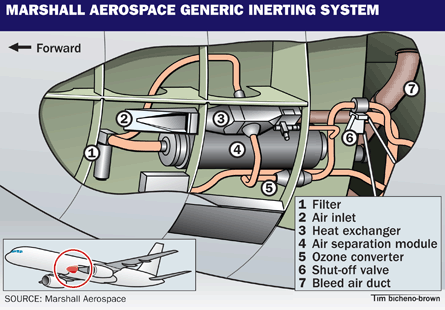Marshall Aerospace is in discussions with several airlines over the provision of a fuel tank inerting modification for their Boeing 757 and 767 fleets.
The UK company expects to install its modular onboard inert gas generating system (OBIGGS) on an aircraft for the first time next year, with the safety enhancement now in the design and risk-reduction phase.
"We are looking at OBIGGS solutions for the 757-200/300 and the 767-300/300ER and 400ER," says commercial inerting project manager Richard Milne. Workshop sessions have already been held with potential customers, and the company has also studied offering the enhancement for the Airbus A320.
The use of common systems and components will reduce spares demands and training requirements for airlines operating types from both manufacturers, he adds.
Marshall launched its commercial retrofit programme in response to a US Federal Aviation Administration regulation which calls for all carriers to install the safety enhancement. Approved after an investigation into the 1996 loss of a TWA 747-100 after a centre fuel tank explosion, Special Federal Aviation Regulation 88 requires half of an airline's fleet to be equipped with nitrogen fuel tank inerting equipment by 2014, and the remainder by 2017.
 |
|---|
"We are developing a product to support the airlines to do that job," says Philip Windred, managing director of Marshall Aerospace's Technology, Products & Services business unit.
"The competitors are the original equipment manufacturers, but they are designing systems for new aircraft. We are convinced that there are significant advantages, primarily in the installation time, with not having to integrate it with the rest of the aircraft systems," he says.
The Marshall design uses air separation membrane technology, which strips out oxygen and carbon dioxide from cooled bleed air before pumping almost pure nitrogen into the ullage of a centre wing fuel tank. The palletised equipment will be installed during a planned period of heavy maintenance by the company, an airline or a third-party support organisation.
For the 757, the installation is in the belly fairing, and comprises two air separation modules, a heat exchanger and a network of pipes running to the centre wing tank.
Marshall is meanwhile expanding its production of auxiliary fuel tanks, and will install its first examples on an A318 Elite at its Cambridge airport site from next month. The work builds on previous orders to produce auxiliary fuel tanks for the Boeing 747, 777-200LR and the US Navy's 737-based P-8 Poseidon maritime patrol aircraft.
The company has delivered the first three shipsets of six under-floor tanks each for the P-8, and will increase output to 66 tanks in 2011 and around 150 a year at full rate, says Steve Thomas, head of operations for Marshall Aerospace Aerostructures.
Source: Flight International




















